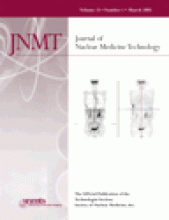Abstract
A woman with papillary thyroid carcinoma treated with surgery and postoperative 131I returned 4 y later for a whole-body survey. The imaging results initially suggested disease recurrence but were later found to be false positive and due to 131I uptake in a necklace that had been contaminated by the patient’s saliva. This case stresses the importance of having the patient remove all jewelry before undergoing a radioiodine survey.
Whole-body radioiodine cancer surveys are an integral part of the diagnostic algorithm for patients with thyroid cancer. Radioiodine has several regions of physiologic uptake, including the salivary glands, the gastrointestinal tract, and the urinary tract, that can have a variable appearance (1–2). In uncharacteristic regions of uptake, contamination must be distinguished from actual disease (3–5).
CASE REPORT
A 25-y-old Russian woman with a history of papillary thyroid carcinoma, which was resected in 1998, underwent a postoperative 131I cancer survey revealing only a small amount of tissue in the thyroid bed, likely remnant thyroid tissue. The patient was treated postoperatively with 2,849 MBq of 131I. The patient returned for a recombinant thyrotropin whole-body survey December 2002 while having near-undetectable levels of thyroglobulin. At first glance, the images (Fig. 1) were suggestive of recurrence of disease at the base of the neck on the left side. After careful consideration, the initial finding was suspected of being false positive. The patient was called at home and agreed to return to the nuclear medicine clinic the following day. Images were taken (Fig. 2) without the necklace. The necklace was then removed and imaged alone and showed activity (Fig. 3). The signature spectrum on a multichannel analyzer confirmed that the necklace activity was from 131I, thus excluding the less likely possibility of an unidentified contaminant, such as a heavy isotope uncommonly contained in Eastern European jewelry. After further questioning, the patient described a habit of placing the necklace in her mouth and confirmed doing so after taking her radioiodine dose. Figure 4 shows the necklace on the patient.
Recombinant thyrotropin whole-body survey that suggests recurrence of disease at base of neck on left side. Shown are 99mTc image with radioactive markers (A) and 131I image (B). Both are anterior views.
99mTc image (A) and 131I image (B) taken without necklace. Both are anterior views.
131I image of necklace alone.
Photograph of necklace on patient.
DISCUSSION
In this patient, a whole-body survey showed a finding that initially created concern about recurrent thyroid carcinoma in the base of the neck but later was revealed to be 131I uptake in a necklace that had been contaminated by the patient’s saliva. This case stresses the importance of having the patient remove all jewelry before undergoing a radioiodine survey.
Footnotes
For correspondence or reprints contact: Sylvain Beaulieu, MD, 1511 Rue Lajoie, Outremont, Quebec, Canada, H2V 1R2.
E-mail: sylvain.beaulieu{at}bigfoot.com











